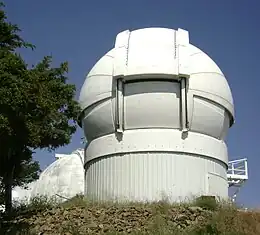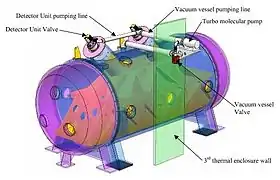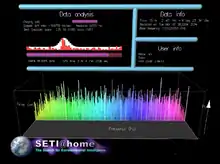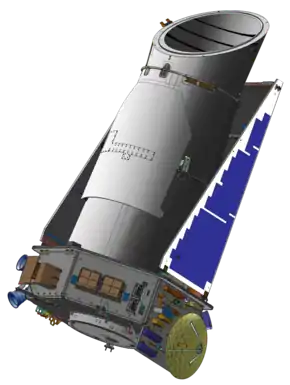Liste de programmes de recherche d'exoplanètes
Cet article présente une liste (aussi exhaustive que possible) de projets de recherche d'exoplanètes.
Projets basés au sol

Dôme du Automated Planet Finder

Spectographe d'ESPRESSO

Capture d’écran du programme SETI@home. Version 4.45.
Passés
- Spectrographe ÉLODIE, installé à l'Observatoire de Haute-Provence de 1993 à 2006, puis remplacé par SOPHIE[1] - [2]
Associations
- East-Asian Planet Search Network (en) (EAPSNET), collaboration de la Chine, de la Corée et du Japon depuis 2005[3]
- N2K Consortium (en), collaboration États-Unis, Chili et Japon depuis 2004[4]
- Microlensing Follow-Up Network (en) (MicroFUN ou µFun), groupe informel d'observateurs depuis 2003[5]
- NASA-UC Eta-Earth, groupe de chercheurs[6]
- PlanetQuest, projet de calcul distribué[7]
- Systemic (en), un projet amateur[8]
Programmes ou instruments liés à des observatoires
- Anglo-Australian Planet Search (en) (AAPS), installé à l'Observatoire astronomique australien depuis 1998[9]
- Observatoire Lick (États-Unis)
- Automated Planet Finder (APF), depuis 2014[10]
- Fiber-Optic Improved Next-Generation Doppler Search for Exo-Earths (FINDS Exo-Earths), depuis 2009[11]
- Spectrographe CORALIE, installé sur le télescope suisse Leonhard Euler à l'observatoire de La Silla au Chili[12]
- Gemini Planet Imager (GPI), à l'observatoire Gemini (Hawaï, États-Unis) depuis 2013[13]
- Geneva Extrasolar Planet Search (en) (Observatoire de Genève), à Versoix (Suisse)
- High Accuracy Radial velocity Planet Searcher (HARPS), installé à l'observatoire de La Silla[14] - [15] depuis 2003[16]
- High Accuracy Radial velocity Planet Searcher for the Northern hemisphere (HARPS-N), au Telescopio Nazionale Galileo depuis 2012[17]
- Université Harvard (États-Unis)
- Projet HATNet (HATNet), basé au Harvard-Smithsonian Center for Astrophysics depuis 1999[18]
- Hunt for Exomoons with Kepler (en) (HEK), affilié au Harvard-Smithsonian Center for Astrophysics et productif depuis 2011[19]
- Projet MEarth, à l'observatoire Fred Lawrence Whipple, productif depuis 2009[20]
- Search for Extra-Terrestrial Intelligence (SETI), depuis les années 1960
- Télescope Subaru (Hawaï, États-Unis)
- Observatoire W. M. Keck (Hawaï, États-Unis)
- Kilodegree Extremely Little Telescope (KELT), États-Unis depuis 2005[26] et Afrique du Sud depuis 2009[27]
- Magellan Planet Search Program, sur les télescopes Magellan (Chili) depuis 2002[28] - [29]
- Sloan Digital Sky Survey, à l'observatoire d'Apache Point (États-Unis) depuis 2000[30]
- Micro-arcsecond University of Sydney Companion Astrometry (MUSCA) de l'université de Sydney (Australie) depuis 2012[31]
- Microlensing Observations in Astrophysics (MOA), collaboration entre des chercheurs de Nouvelle-Zélande et du Japon[32]
- Le Next-Generation Transit Survey (NGTS), à Paranal (ESO/Chili)
- Okayama Planet Search Program (en) (OPSP) à l'Observatoire astrophysique d'Okaya (ja), de l'Observatoire astronomique national du Japon, Kurashiki (Japon) depuis 2001[33]
- Optical Gravitational Lensing Experiment (OGLE), à l'université de Varsovie (Pologne) depuis 1992[34]
- PlanetPol (en), au télescope William Herschel (Espagne), productif depuis 2012[35]
- Observatoire du Mont Palomar (États-Unis)
- PRL Advanced Radial-velocity All-sky Search (en) (PARAS), du Physical Research Laboratory (en) (Inde) depuis 2010[38]
- pre-OmegaCam Transit Survey (POTS)
- Spectrographe pour l’observation des phénomènes des intérieurs stellaires et des exoplanètes (SOPHIE) basé à l'Observatoire de Haute-Provence depuis 2006[39]
- SuperWASP (WASP), aux observatoire du Roque de los Muchachos et South African Astronomical Observatory productif depuis 2006[40]
- Trans-Atlantic Exoplanet Survey (TrES), instruments situés dans trois observatoires : l'observatoire Lowell, l'observatoire du Mont Palomar et ceux des îles Canaries (l'observatoire du Teide, île de Tenerife, et l'observatoire du Roque de los Muchachos, île de La Palma) ; productif depuis 2004[41]
- Télescope XO (en) (XO), (Hawaï, États-Unis) ; utilisé par le projet XO (en) et productif depuis 2006[42]
- Very Large Telescope, Observatoire du Cerro Paranal (Chili) de l'Observatoire européen austral
Planifiés
* Exoplanet imager for the E-ELT (EPICS), basé au European Extremely Large Telescope (Chili) de l'Observatoire européen austral et opérationnel en 2018[44]
Missions spatiales

Le télescope spatial Kepler.
Passées
- Sagittarius Window Eclipsing Extrasolar Planet Search (en) (SWEEPS), basée sur Hubble (États-Unis et Agence spatiale européenne), 2006[46].
- Télescope CoRoT (France et Agence spatiale européenne) – lancé le , mission terminée en 2013[47]
- Sonde spatiale EPOXI, utilisant Deep Impact (États-Unis) – de 2008 à 2013[48]
En cours
- Télescope spatial MOST (Canada) – lancé le [49]
- Télescope spatial Kepler du programme Exoplanet Exploration (ExEP) (États-Unis) – lancé le [50]
- Satellite Gaia de l'Agence spatiale européenne – lancé le [51]
- Télescope spatial Transiting Exoplanet Survey Satellite (TESS) (États-Unis) – lancé le 18 avril 2018
- Télescope spatial CHEOPS (Suisse et Agence spatiale européenne) – lancé le 18 décembre 2019[52]
À venir
- Télescope spatial James-Webb (États-Unis, Canada et Agence spatiale européenne) – lancé en 2021[53]
- Observatoire spatial PLATO de l'Agence spatiale européenne – lancement prévu en 2024[54]
- Télescope spatial infrarouge Wide Field Infrared Survey Telescope (WFIRST) du programme Exoplanet Exploration (ExEP) – lancement prévu en 2025[55]
Proposées
- Télescope spatial Advanced Technology Large-Aperture Space Telescope (en) (ATLAST), du Space Telescope Science Institute (États-Unis)[56]
- Programme Explorer de la NASA (États-Unis)
- Télescope spatial Exoplanetary Circumstellar Environments and Disk Explorer (en) (EXCEDE)[57]
- Observatoire spatial Fast Infrared Exoplanet Spectroscopy Survey Explorer (FINESSE)[58]
- Occulteur spatial Mission New Worlds, du NASA Institute for Advanced Concepts (États-Unis)[59]
- Observatoire spatial PEGASE (en), du Centre national d'études spatiales (France)[60]
Annulées
- Satellite Eddington, mission annulée en 2003[61]
- Télescope spatial Darwin, annulé en 2007[62]
- Télescope spatial Terrestrial Planet Finder, annulé en 2007[63]
- Télescope spatial Space Interferometry Mission, annulé en 2010[64]
- Télescope spatial Exoplanet Characterisation Observatory (EChO), du programme Cosmic Vision de l'Agence spatiale européenne, annulé en 2014[65]
Source
- (en) Cet article est partiellement ou en totalité issu de l’article de Wikipédia en anglais intitulé « List of exoplanet search projects » (voir la liste des auteurs).
Références
- The ELODIE-SOPHIE Archive in the Virtual Observatory, S. Ilovaisky, Ph. Prugniel, C. Soubiran, M. Koleva, and H. Le Coroller, in Astronomical spectroscopy and the Virtual Observatory, Madrid (Spain), 21–23 mars 2007, Madrid, 2007.
- A user's guide to Elodie archive data products, Elodie archive, Observatoire de Haute Provence. Consulté le 15 juin 2008.
- Izumiura, Hideyuki, « An East-Asian Extra-Solar Planet Search Network », Journal of the Korean Astronomical Society, vol. 38, no 2, , p. 81-84 (lire en ligne)
- Site du projet N2K
- Site du groupe µFUN
- Résumé du projet « NASA-UC Eta-Earth Survey »(Archive.org • Wikiwix • Archive.is • Google • Que faire ?) (consulté le )
- Site du projet PlanetQuest
- Site du projet Systemic
- Site du programme Anglo-Australian Planet Search
- Site web du télescope APF
- Site web du programme FINDS Exo-Earths
- Queloz et al., M. Mayor, L. Weber, A. Blécha, M. Burnet, B. Confino, D. Naef, F. Pepe et N. Santos, « The CORALIE survey for southern extra-solar planets. I. A planet orbiting the star Gliese 86 », Astronomy and Astrophysics, vol. 354, , p. 99–102 (Bibcode 2000A&A...354...99Q)
- Bruce Macintosh, « The Gemini Planet Imager », Proceedings of SPIE, vol. 6272, , p. 62720L-62720L-12 (DOI 10.1117/12.672430, lire en ligne, consulté le )
- David Darling, "Geneva Extrasolar Planet Search Programs", The Encyclopedia of Astrobiology, Astronomy, and Space Flight, 7 mai 2007.
- Mayer et al., « The Geneva Extrasolar Planet Search Programmes » (consulté le )
- Mayor et al., F. Pepe, D. Queloz, F. Bouchy, G. Rupprecht, G. Lo Curto, G. Avila, W. Benz, J.-L. Bertaux, X. Bonfils, Th. Dall, H. Dekker, B. Delabre, W. Eckert, M. Fleury, A. Gilliotte, D. Gojak, J. C. Guzman, D. Kohler, J.-L. Lizon, A. Longinotti, C. Lovis, D. Megevand, L. Pasquini, J. Reyes, J.-P. Sivan, D. Sosnowska, R. Soto, S. Udry et A. Van Kesteren, « Setting New Standards With HARPS », ESO Messenger, vol. 114, , p. 20 (Bibcode 2003Msngr.114...20M, lire en ligne)
- Site du projet HARPS-N
- G. Á. Bakos, J. Lázár, I. Papp, P. Sári et E. M. Green, « System Description and First Light Curves of the Hungarian Automated Telescope, an Autonomous Observatory for Variability Search », Publications of the Astronomical Society of the Pacific, vol. 114, no 799, , p. 974–987 (DOI 10.1086/342382, Bibcode 2002PASP..114..974B, arXiv astro-ph/0206001, lire en ligne)
- Hunt for Exomoons with Kepler, « News Archive », Hunt for Exomoons with Kepler, Hunt for Exomoons with Kepler, (consulté le )
- « MEarth: looking for transiting, habitable super-Earths around small stars » (consulté le ).
- Description de l'instrument HiCIAO
- Motohide Tamura, « Subaru Strategic Exploration of Exoplanets and Disks with HiCIAO∕AO188 (SEEDS) », AIP Conference Proceedings, vol. 1158, no 1, , p. 11–16 (DOI 10.1063/1.3215811, lire en ligne)
- NASA, « Kepler Discoveries - About Follow-up Observations », NASA
- « The NASA-UC Eta-Earth Survey�At Keck Observatory », Chinese Academy of Sciences, (consulté le )
- The California Planet Survey I. Four New Giant Exoplanets
- Joshua Pepper, Richard Pogge, D. L. Depoy, J. L. Marshall, K. Z. Stanek, Amelia Stutz, Shawn Poindexter, Robert Siverd, Thomas o’Brien, Mark Trueblood et Patrica Trueblood, « The Kilodegree Extremely Little Telescope (KELT): A Small Robotic Telescope for Large-Area Synoptic Surveys », Astronomical Society of the Pacific, vol. 119, no 858, , p. 923 (DOI 10.1086/521836)
- Pepper et al, « The KELT-South Telescope », Publications of the Astronomical Society of the Pacific, vol. 124, no 913, , p. 230–241 (DOI 10.1086/665044, Bibcode 2012PASP..124..230P, arXiv 1202.1826)
- D. Minniti, « Low Mass Companions for Five Solar-Type Stars from the Magellan Planet Search Program », The Astrophysical Journal, vol. 693, no 2, , p. 1424–1430 (DOI 10.1088/0004-637X/693/2/1424, Bibcode 2009ApJ...693.1424M, arXiv 0810.5348)
- P. Arriagada, « Five Long-period Extrasolar Planets in Eccentric orbits from the Magellan Planet Search Program », The Astrophysical Journal, vol. 711, no 2, , p. 1229–1235 (DOI 10.1088/0004-637X/711/2/1229, Bibcode 2010ApJ...711.1229A, arXiv 1001.4093)
- Site du programme SDSS
- Yitping Kok, Astrometry, a potential exoplanet search technique, and SUSI
- Site du projet MOA
- « Planetary Companions around Three Intermediate-Mass G and K Giants: 18 Delphini, Xi Aquilae, and HD81688 », http://www.oao.nao.ac.jp (consulté le )
- Site du projet OGLE
- J. H. Hough, « PlanetPol: A Very High Sensitivity Polarimeter », The Publications of the Astronomical Society of the Pacific, vol. 118, no 847, , pages 1302–1318 (DOI 10.1086/507955, Bibcode 2006PASP..118.1302H, lire en ligne, consulté le )
- Site du Projet 1640
- (en) Sara Seager, Exoplanets, University of Arizona Press, , 526 p. (lire en ligne), p. 167.
- First Light results from PARAS: The PRL Echelle Spectrograph, Abhijit Chakraborty et.al, 2010.
- Site de SOPHIE
- Wide-eyed Telescope Finds its First Transiting Planets Around Distant Stars (PDF requires acrobat reader)
- Roi Alonso, Timothy M. Brown, Guillermo Torres, David W. Latham, Alessandro Sozzetti, Georgi Mandushev, Juan A. Belmonte, David Charbonneau et Hans J. Deeg, « TrES-1: The Transiting Planet of a Bright K0V Star », The Astrophysical Journal Letters, vol. 613, no 2, , L153–L156 (DOI 10.1086/425256, Bibcode 2004ApJ...613L.153A, arXiv astro-ph/0408421, lire en ligne)
- Site du projet XO
- « ESPRESSO - Searching for other Worlds », Centro de Astrofísica da Universidade do Porto, (consulté le )
- Govert Schilling, « Europe Downscales Monster Telescope to Save Money », Science Insider, (lire en ligne, consulté le )
- H. M. Schmid, « ZIMPOL/CHEOPS: a Polarimetric Imager for the Direct Detection of Extra-solar Planets », Astronomical Polarimetry: Current Status and Future Directions ASP Conference Series, Vol. 343, Proceedings of the Conference held 15–19 March 2004 in Waikoloa, Hawai'i, USA. Edited by A. Adamson, C. Aspin, C. J. Davis, and T. Fujiyoshi, , p. 89 (lire en ligne, consulté le )
- « SIMBAD Details on Acronym: SWEEPS », SIMBAD, Centre de Données astronomiques de Strasbourg (consulté le ).
- Exoplanètes - Rêves de nouvelles planètes, Jérôme Fenoglio et Christiane Galus, Le Monde, 27 décembre 2006
- Site d'« EPOXI »(Archive.org • Wikiwix • Archive.is • Google • Que faire ?) (consulté le )
- Site de « MOST »(Archive.org • Wikiwix • Archive.is • Google • Que faire ?) (consulté le )
- Site de Kepler
- Site de Gaia
- Site de CHEOPS
- Site du télescope
- Site de PLATO
- Site de « WFIRST »(Archive.org • Wikiwix • Archive.is • Google • Que faire ?)
- Site de ATLAST
- Site de EXCEDE
- Site de « FINESSE »(Archive.org • Wikiwix • Archive.is • Google • Que faire ?) (consulté le )
- Site de New Worlds
- Pegase: a space-based nulling interferometer
- Europe Scaling Back 6 Nov 2003
- « Darwin factsheet: Finding Earth-like planets » [archive du ], European Space Agency, (consulté le )
- Le projet lancé en 2004 ne figure plus dans le budget prévisionnel de l'exercice 2007 de l'agence spatiale américaine.
- (en) « Updates from the Project Manager », site SIM Lite,
- « ESA selects planet-hunting PLATO mission », ESA, (consulté le )
Cet article est issu de wikipedia. Text licence: CC BY-SA 4.0, Des conditions supplémentaires peuvent s’appliquer aux fichiers multimédias.